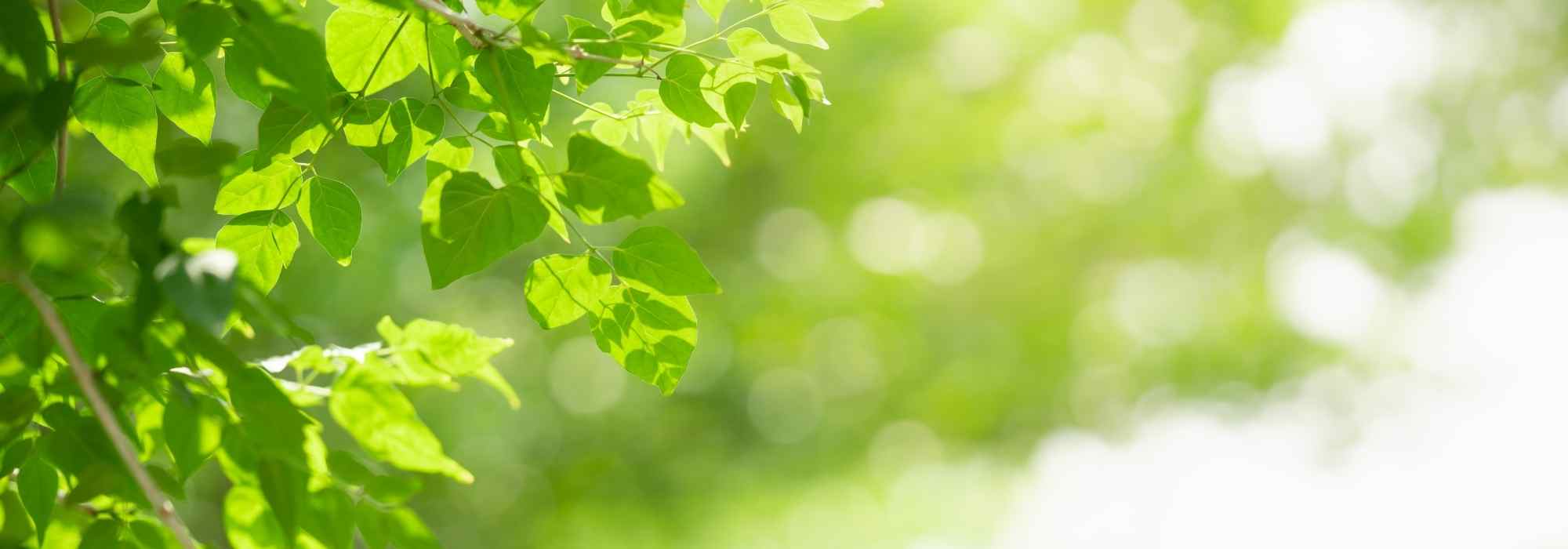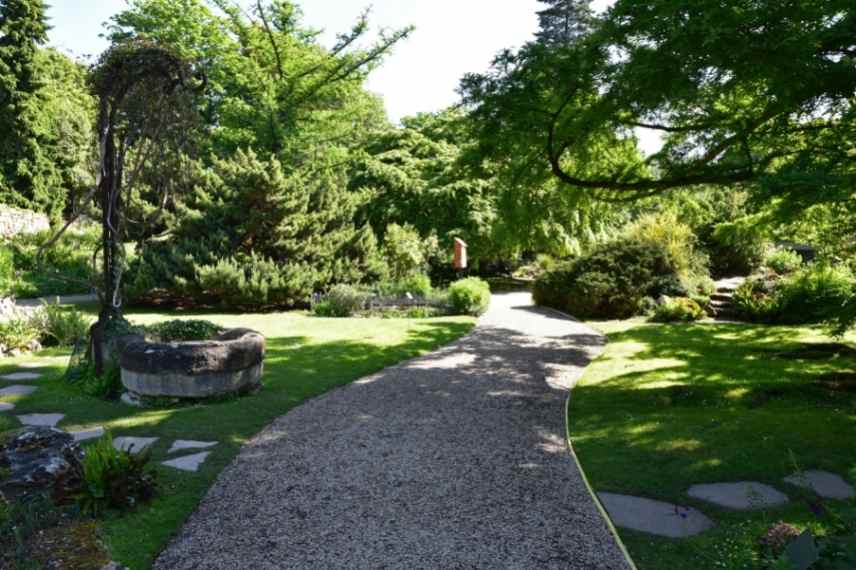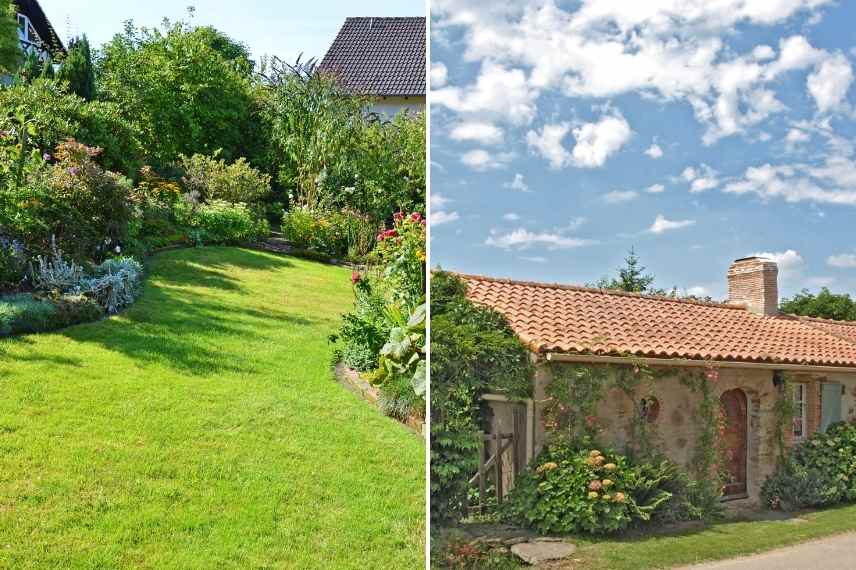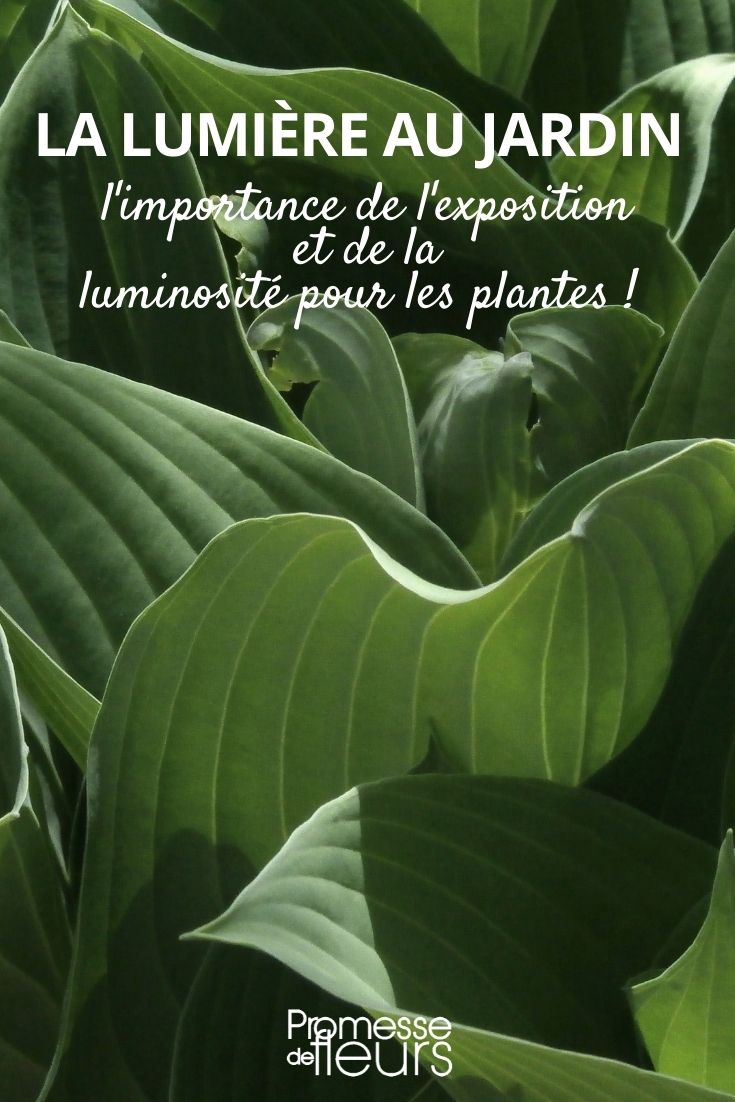
Light in the garden: exposure, sunlight, shading, and brightness
Understanding these essential concepts for plants
Contents
Along with water, light is the essential element for plants to grow and develop. We can appreciate its power when we observe certain plants contorting themselves to receive more of it. When enhancing your garden with new plants, it is crucial to understand their needs so that they are suited to the new growing conditions, particularly the number of hours of sunlight dictated by their exposure. This information is always indicated in the characteristics of a plant.
But what about the terms shade, partial shade, and sun? Are all shades or sunlight conditions comparable? What is the influence of light on our perception in the garden? Let’s revisit some basic yet essential concepts to understand the importance of light for our plants.
 Shade and light are integral parts of a garden, in different relationships depending on the proportion of trees
Shade and light are integral parts of a garden, in different relationships depending on the proportion of trees
Please provide the text you would like to have translated.
To begin with, several phenomena and terminologies related to light in plants can be noted:
The somewhat obscure term phototropism refers, in botany, to the attraction exerted on a plant by light. Although they are static, anchored in the soil by their roots, plants are not without movement, and some end up adopting a strangely twisted “posture” to seek out light if they have been planted against their needs, or if surrounding vegetation has taken too much hold and blocks their light.
We also think of sunflowers that inevitably turn towards the light during the day: this is known as heliotropism (positive), which refers to the variation in the orientation of leaves or certain flowers to follow the light and increase their photosynthesis.
As for flowers or leaves that open and close at night—or vice versa (such as the evening primrose and many legumes)—this is referred to as nyctinasty or more precisely light-related photonasty: plants react to changes in light intensity and the onset of darkness for various reasons (such as nocturnal pollination for some).
Finally, you may sometimes encounter the term sun-loving plant: these are plants that thrive and require sunlight (helios in Greek) to grow properly, such as Cistus or many grasses.
In addition to these purely physical characteristics adopted by plants, it is also important to detail the concepts of exposure and shading to which plants will inevitably be subjected…
 On the left, a twisted lilac, seeking the light… On the right, the flowers of Mirabilis or Evening Primrose, closing during the day
On the left, a twisted lilac, seeking the light… On the right, the flowers of Mirabilis or Evening Primrose, closing during the day
Sunlight, brightness, shade... nuances to consider
The orientation of a house, a building, and thus a garden influences the degree of light received. The sun rises in the East in the morning, then moves to the South, and finally sets in the West. Plants that do not intersect this sun’s trajectory will not receive sunlight, as is the case with a North-facing exposure. However, the sunlight—and the resulting warmth—that increases from spring will not be the same in the full day in the South as it is in the morning in the East or in the evening in the West. This is an important criterion to consider, beyond mere exposure, for the development of plants.
When considering the sunlight or shade of an area, the exposure (or orientation) North, East, South, or West is the key to getting it right. But the concept of brightness does not necessarily imply sunlight. A bed in the north-east can remain bright if it is open. If it is not located under the foliage of trees or competing with a dense hedge, for example.
Moreover, one must also consider the different seasons when the sun is higher or lower, and thus more or less present. This is a factor that is important to observe over several months. It is often advised to experiment with a garden across the four seasons to fully understand its sunny and shaded areas (notably due to the long shadows that extend significantly in winter), thus avoiding mistakes in planting. Shaded areas in summer, because they are under tree cover, often become sunny in spring when the foliage has not yet started, allowing for the planting of certain bulbous plants like early tulips or daffodils, for example.
The architecture of a place will also play a role in the shading relationships. A shadow can be very present and dense for a good part of the year if a building is tall. Conversely, long and low houses, such as those found in Vendée, the longère type homes, and some Provençal villas or farmhouses, will receive sunlight on the north side in summer much earlier than one or two-storey buildings.
In the same vein, external views into the garden have a significant impact on the provision of shade. In the case of housing estates where houses are quite close to each other, the positioning of a tall wall near beds will provide a certain amount of shade throughout the year, especially a dense shadow.
Finally, another determining factor is the geographical area. Depending on whether one lives in Amiens or Marseille, the brightness is obviously not the same. For example, one might say that a bush like the Choisya ternata (Mexican orange blossom) will thrive in the sun in the Northern regions, but will require partial shade, or even shade, in the southernmost regions of the country.

Summer shading is reduced by the sun’s high position in the sky. On the right, a typical low house from the Pays de Retz in Vendée.
Shade, partial shade, or sun: what do we mean by that?
The concepts of exposure are not always easy to understand, as the terms “shade”, “partial shade”, or “sun” labelled on plants can be confusing. However, it is essential to grasp these concepts, as a perennial planted in partial shade instead of full sun, as should be the case for a sage, will survive but will flower much less. It is also worth noting that a plant meant for partial shade planted in full shade (like a Japanese anemone) will flower later but also for a longer period than if it were exposed to more sun. Finally, a shade plant generally thrives in partial shade, where it often produces a more generous flowering.
Average sunlight hours are considered for each of these exposures:
- Shade: less than 4 hours of sun per day
- Partial shade: between 4 and 6 hours of sun per day
- Sun: 7 hours of sun or more per day.
It is important to note that the more intense sun of southern regions does not have the same value as a lower light intensity in northern France. As mentioned earlier, partial shade can be understood as a sunny situation in the north, and shade as a partially shaded situation in these colder regions.
As for perennials or bushes labelled “sun”, it should be understood that for these plants, a minimum of 7 hours of sunlight is essential to ensure beautiful flowering and good vegetative behaviour, typically requiring a full south exposure.
N.B.: there are plants that can thrive in both shade and full sun, which are practical when a shaded area in winter turns into a blazing suntrap in summer months.

Perennials for full sun, shade plants with beautiful foliage like hostas and ferns, and perennials that thrive in partial shade.
Read also
12 evergreen bushes to plant in full sunThe different types of shade
Let’s take a closer look at shade, or rather shades, as it is often a problematic issue for many gardeners. In reality, we distinguish several types of shade, induced by different mechanisms:
- Dense shade: this is generally produced by large trees or those with broad leaves such as walnut, beech, horse chestnut, cherry, or large evergreen trees like conifers. It is an inhospitable shade for most plants;
- Partial shade or “cool” shade, such as that found at the foot of an east-facing wall: the sun is present in the morning, but it is still timid and not very warming, or it can be partial shade under foliage with dense branches. To the north, a wall will create a cold shade, which is much more problematic than the shade from trees, which, if deciduous, allow light to pass through and especially protect plants from wind and cold in winter;
- Light or partial shade, which, it must be admitted, is not always easy to visualise. It is actually a type of partial shade often filtered by a tree or bush, either small in size or with very airy branches or finely cut or small leaves like those of an Albizia, a Japanese maple, or a birch;
- Warm partial shade: this exists in a west-facing position, as the sun is present for longer and heats much more.
Beware! A severe pruning or, conversely, a construction rising close to existing plantings will radically alter the shading areas: either by bringing in a lot of sunlight or, on the contrary, by introducing previously non-existent shade. Therefore, before proceeding with drastic cutting back of shrubs or the removal of a large tree, you will need to assess the impact this will have on your existing beds.
Light games
Each plant has an optimal light that highlights it, depending on the colour of its foliage or flowers. For example, blue flowers are more beautiful and less washed out in partial shade than in full sun under saturated light.
The season also plays an interesting role: under low winter light or the rosy rays of a summer evening, plants will be coloured differently. Thus, red flowers are enhanced by the setting sun, while the light culms of grasses appear magical under a winter morning sun. The winter light, whiter and softer, should be considered for the flowering of certain bushes like the Hamamelis: it is always recommended to place them in lateral light to showcase their full flair!
Also think about backlighting that reveals pale flowers and wide petals like those of peonies, as well as those with veined or graphic foliage like palms, the Begonia grandis, etc.
Also discover our article on the perception of flower colours!

Playing with light… plants love it!
- Subscribe!
- Contents
































Comments